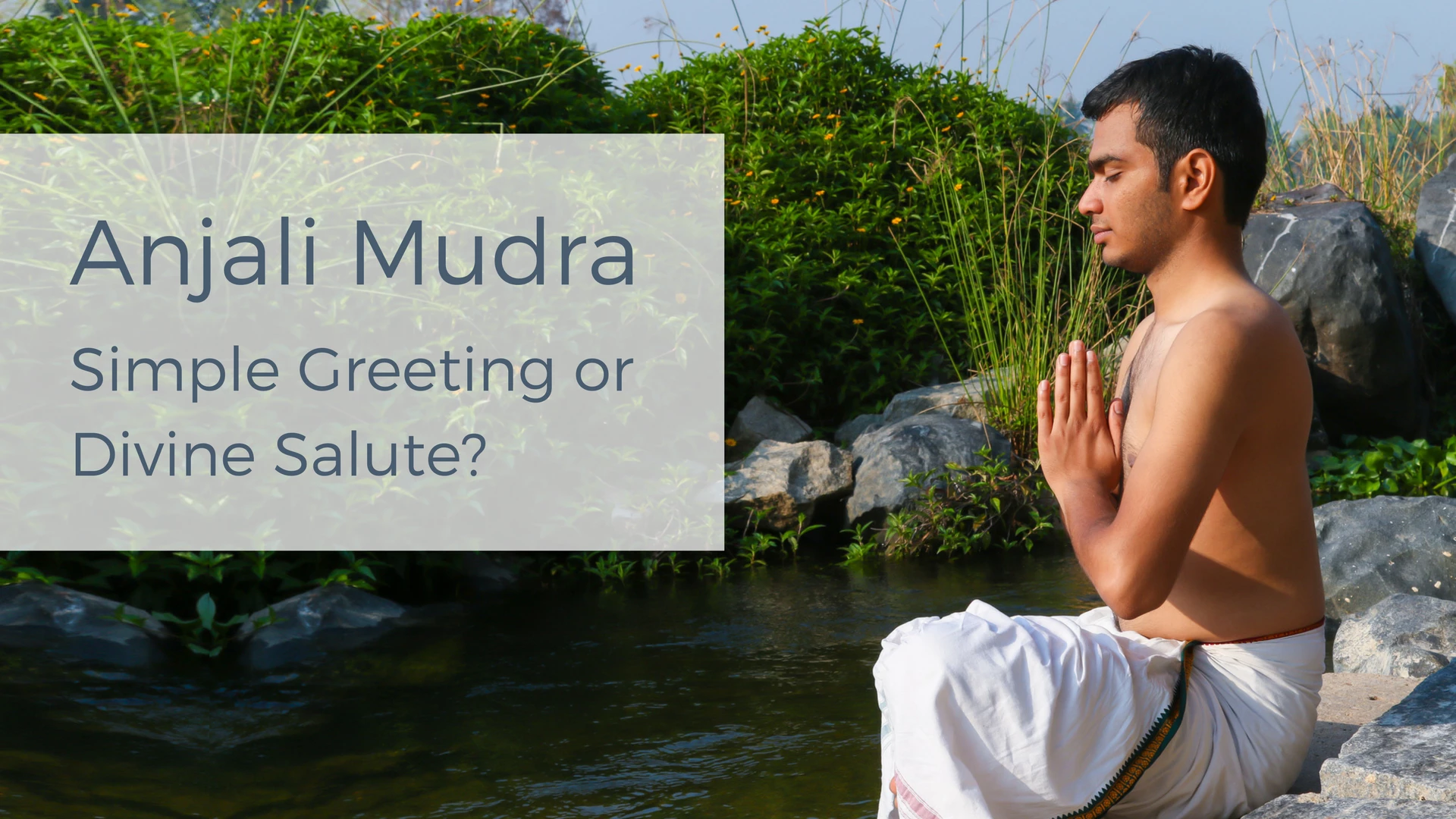Anjali Mudra – Simple Greeting or Divine Salute?

Few positions are more ubiquitous in yoga practice than Anjali Mudra (Prayer Position). We often practice Anjali Mudra to begin and end a class. We begin and end Surya Namaskar (Sun Salutation) in Anjali Mudra. On silent meditation retreats, since verbal communication is verboten, it can mean lots of things: “I acknowledge you,” “thank you,” “may I pass by?” or “hello.”
Anjali Mudra’s roots span Buddhist, Hindu, Jain, and Sikh traditions. As such, its meaning, and the meaning of its often accompanying verbalization, namaste, is subject to lots of interpretations.
In many Western yoga asana classes, Anjali Mudra, accompanied by “Namaste,” is interpreted to mean, “The divine in me bows to the divine in you.” Many traditional practitioners, however, consider this interpretation to be a Western overlay to what is really meant to be a simple “hello.” The literal meaning of “Namaste” is “I salute you.”
When I traveled to India, Anjali Mudra was used as a simple, respectful greeting, a kind acknowledgment of the momentary meeting of two individuals.
It can be confusing to sort out all the meanings humans have applied to Anjali Mudra and namaste. Which one is the “true” meaning? I guess we have to honor the source of each interpretation. I tend to prefer one Buddhist’s interpretation that I heard many years ago—that Anjali Mudra simply means “welcome.”
No matter the specific meaning, Anjali Mudra, whether or not it’s accompanied by “namaste,” is a gesture of respect and greeting. While there is no documented scientific evidence of this, some yoga teachers claim that joining our hands at the heart center integrates the two hemispheres of the brain. Still, others claim that it strengthens the heart. Who knows?
Anjali Mudra: Firm And Soft
I like to practice Anjali Mudra after sitting meditation. For me, the joining of my hands over my heart allows me to feel the energy exchange between my hands. The quality of contact—meaning how hard or soft I find myself pressing—tells me about the state of my mind. Firm pressure indicates strong intention, but if I press too firmly, the natural exchange I feel between my hands becomes dull or numb. Too light a touch feels disconnected. Here again, the energy flow between your hands will not be clear. So I practice to find balance.
Remember that Sutra 2.46 in Patanjali’s Yoga Sutras says, “The physical posture is steady and comfortable,” or in other translations “firm and soft,” “steady and easy.”
 Practicing Anjali Mudra Yoga Pose
Practicing Anjali Mudra Yoga Pose
-
Sit in Sukhasana (Easy Pose) or stand in Tadasana (Mountain Pose).
-
Join your palms at chest level, with your thumbs touching your sternum.
-
Allow your fingers, thumbs and heels of your hands to touch. The knuckles at the base of your fingers may or may not be in contact.
-
Close your eyes. This is optional, but for many of us, this can help focus awareness inward.
-
Feel the contact between your hands. Are you pressing hard? Or do the hands feel as if they are pulling away from one another? Find what feels like balance for you at this moment.
-
Tune in. What is the sensation of contact? How would you describe it—tingling, pressure, vibration or something else entirely?
-
Stay for 5 to 10 deep, relaxed breaths and notice how these sensations change over time.
-
Release your hands down to your sides.
However you choose to interpret Anjali Mudra, practice it on its own. Practicing Anjali Mudra by itself helps you develop your own relationship with this wonderful yoga pose.
In the Kalama Sutta, the Buddha said: “ … don’t go by reports, by legends, by traditions, by scripture, by logical conjecture, by inference, by analogies, by agreement through pondering views, by probability, or by the thought, ‘This contemplative is our teacher.’ When you know for yourselves that, ‘These qualities are skillful; these qualities are blameless; these qualities are praised by the wise; these qualities, when adopted and carried out, lead to welfare and to happiness’ — then you should enter and remain in them.”
With practice, you can discover Anjali Mudra for yourself.
Read more about Mudras in your yoga practice in this article from YogaUOnline and Baxter Bell, MD – Building Presence in Your Practice: The Power of Mudras.
Reprinted with permission from Hugger Mugger Yoga Products’ blog.
 Charlotte Bell began practicing yoga in 1982 and began teaching in 1986. She was certified by B.K.S. Iyengar in 1989 following a trip to Pune. In 1986, she began practicing Insight Meditation with her mentors Pujari and Abhilasha Keays. Her asana classes blend mindfulness with physical movement. Charlotte writes a column for Catalyst Magazine and serves as editor for Yoga U Online. She is the author of two books: Mindful Yoga, Mindful Life and Yoga for Meditators, both published by Rodmell Press. She also edits Hugger Mugger Yoga Products¹ blog and is a founding board member for GreenTREE Yoga, a non-profit that brings yoga to underserved populations. A lifelong musician, she plays oboe and English horn in the Salt Lake Symphony and the folk sextet Red Rock Rondo whose 2010 PBS music special won two Emmys.
Charlotte Bell began practicing yoga in 1982 and began teaching in 1986. She was certified by B.K.S. Iyengar in 1989 following a trip to Pune. In 1986, she began practicing Insight Meditation with her mentors Pujari and Abhilasha Keays. Her asana classes blend mindfulness with physical movement. Charlotte writes a column for Catalyst Magazine and serves as editor for Yoga U Online. She is the author of two books: Mindful Yoga, Mindful Life and Yoga for Meditators, both published by Rodmell Press. She also edits Hugger Mugger Yoga Products¹ blog and is a founding board member for GreenTREE Yoga, a non-profit that brings yoga to underserved populations. A lifelong musician, she plays oboe and English horn in the Salt Lake Symphony and the folk sextet Red Rock Rondo whose 2010 PBS music special won two Emmys.



